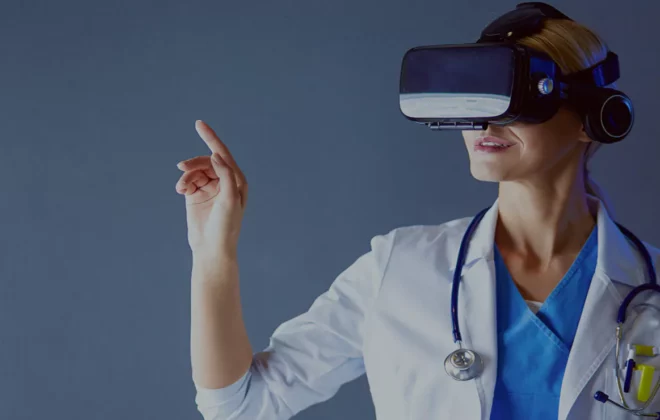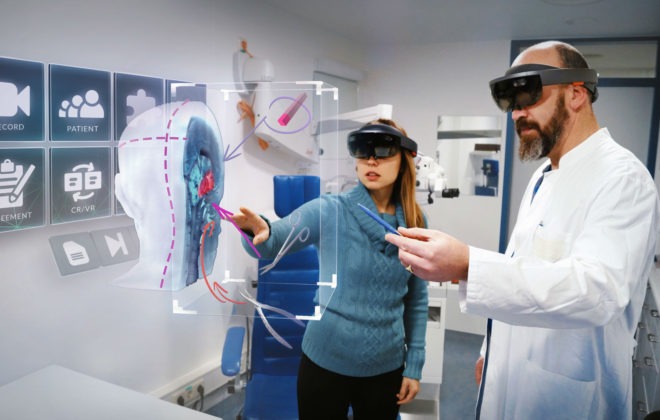The Future of Medical Training: Harnessing VR and Emerging Technologies
The healthcare industry today stands as the first and the most crucial one among other sectors. The development and innovations for healthcare services are unlimited. But, the fact is the medical industry is growing at a faster pace with AI and VR technologies. Implementing emerging technologies for the future of medical training is most welcome. Do you imagine how it would be in the future? Yeah! Medical training will be implemented via VR and emerging technologies. It helps doctors, medical students and patients to experience a new trendy setting in healthcare apps.
So, in this post, we can witness the future of medical training via VR and emerging technologies in detail. You can limit your imagination in working with the future of the medical field using the latest technologies.
Objective:
The objective of this article is to witness the evolution of medical training, VR in medical training, implementing emerging technologies, future trends, and innovations along with challenges in detail.
Virtual reality in healthcare education has great potential in multiple healthcare streams. So, you will learn how the future of medical training harnesses VR and the latest technologies in detail as well.
Importance:
VR is already creating a milestone in the medical industry. The latest innovations in the medical field are already in circulation. But imagine how it would be in the future.
VR is a trendsetter in medical training to help classroom learners apply practice and learn from their mistakes more easily. The importance of using VR is to focus on enhancing competencies and emphasizing autonomous learning. As VR continues to streamline medical training, it becomes mainstream.
The Evolution of Medical Training
☛ Overview of medical training methods and their evolution
Medicine has evolved over the centuries. It reflects scientific knowledge and social needs and indulges methodologies. In the earlier days, medical training will be given by professional and experienced medical teachers and authors.
It includes classroom study with a trainee to handle the student’s academy. From ancient practices to modern-day medical education, the journey is long and transformative as well. The medical industry today is moving forward with advancements.
☛ The current state of medical training
As the world is transforming digitally, everything is accessible at a fingertip. The medical industry has had a significant development in recent years. For example, patients can get appointments over online calls and messages.
Medical students cannot go to the teacher’s cabin to get their doubts cleared. Rather, VR is giving instruction and clear-cut solutions for the students, staff, and patients as well. It hinders a deeper understanding of human anatomy and other departments.
☛ Challenges and limitations
Traditional medical training is somewhat what we learned in the early 90s and 20s. Those days, medical students prefer classroom teaching and learn practically as well. The field of the medical sector has utilized traditional learning methods so far.
Some things could be improved with the traditional medical training. Some of them are easily resolved, but something will only change now. To overcome those hurdles for medical students and doctors, there must be innovations to be implemented in future development.
The goal is to equip future medical professionals with high-tech skills and knowledge. So, there must be rapidly changing technology needed immediately in the future scope.
Virtual Reality In Medical Training
☛ Define VR and its applications in medical education and training
Virtual Reality is a simulation experience for users to employ 3D sensors for display and tracking. It gives users an immersive feel of a virtual world experience. Users can interact with various elements realistically. But, in the medical field, it is a must one to use. It is completely safe for students and patients.
☛ Applications of VR in education and training
- VR in healthcare
- VR in surgery
- VR in the rehab center
- VR in stroke
- VR in pain management
☛ Benefits of VR:
-
Immersive learning:
VR in medical training enables medical students and doctors to learn by doing. Of course, it provides a good environment to do experimental purposes and regular practice.
They can work and simulate real-life scenarios. Medical training will be engaging with interactive objects to understand complex ideas at a fingertip.
-
Risk-free practice:
VR provides medical students with realistic and immersive simulations. It will be engaging with real-time concepts and use cases to understand deeply. So, there might be a direct collaboration with students to learn and understand complex tasks.
-
Enhanced engagement:
VR in medical training is completely a boon for creating an immersive environment. Students can easily interact with virtual products as they come into real-world experiments. The level of interaction will be engaging and motivate them to learn faster by watching videos.
-
Real-world applications:
VR is not currently used in many healthcare industries. Some real-world applications are to evolve in the study for your better understanding. Some of them are listed below.
- Development of medical skills
- Trauma and emergency room simulation
- Surgical training
- Pain management
- Empathy
- Study of anatomy
Emerging Technologies In Medical Training
☛ Augmented reality (AR):
In the modern day, Medical education is quite a challenging option due to the varied complex procedures. High stakes are involved in practicing medicine. The recent advancement in technology has massively improved the era of learning.
AR simulation enhances the learning experience by bringing the students with a better interactive and engaging platform. The AR in medical training is helpful for analyzing medical procedures and gives an immersive experience. It helps students to retain the information in a better, improved manner.
Augmented Reality (AR) simulation in medical education brings better ability for practicing each procedure even without harming patients. Normally, students can make mistakes during practice sessions, and this technology helps to learn and improve their skills.
☛ Artificial intelligence (AI):
-
Personalized learning:
Implementing AI-driven platforms in medical training helps learners enhance their skills. Artificial Intelligence (AI) in medical training provides a personalized learning experience for students.
These AI-powered platforms are suitable options for analyzing the strengths and even weaknesses of individual students. The emerging medical training technologies allow educators to modify teaching methods. These extensively meet the specific needs of each student by providing accurate and relevant information.
-
Simulation and predictive modeling:
AI algorithms help to simulate complex medical scenarios along with the predict outcomes. Artificial Intelligence has been used in medical training to easily analyze vast datasets, and it identifies
- Patient information
- Medical history
- Symptoms
- Test results
-
Haptics and robotics:
Integration of haptic feedback along with robotics in medical training leads to a better learning atmosphere. Haptic feedback technology in medical training creates a realistic experience. These are significant for learning the complete process of the medical practice or surgery in a safe environment,
-
3D Printing:
Leveraging Artificial intelligence and 3D printing techniques improves diagnostic accuracy to the highest level. It also leads to earlier detection of diseases and easily improves patient outcomes.
These are helpful for creating anatomical models for hands-on practice. It gives the realistic and mimics actual human parts even without any hassle. It also efficiently makes the operational process accurate and effective.
Future Trends And Innovations:
Augmented Reality (AR) is being utilized in medical training to improve the skills of students. Creating realistic and immersive simulations lets the students practice complex procedures even in a safer environment. Augmented Reality (AR) technology helps to visualize complex anatomical structures in 3D.
☛ Integrative learning platforms:
Medical education has undergone a massive transformation with advancements in Integrative Learning Platforms. These make teaching and assessment easier with integrated learning.
An Integrative Learning Platform enables classroom training in digital formats. Students can connect theoretical knowledge with practical experiences effectively. Augmented Reality platforms combine multiple technologies for making Continuous assessment and lower-stakes evaluations.
☛ Remote training and telemedicine:
Remote Training and Telemedicine platforms help to enhance communication levels between doctors and patients. It also helps to access healthcare data making distant monitoring easier. Various devices such as audio-video software, digital wearable devices, and many others are used. Remote Training helps to access training material quickly from home.
☛ Ethical and regulatory considerations:
Improving healthcare outcomes in the digital era is greater with various technologies such as AR, AI, and more. Advanced technologies in medical training allow us to easily address ethical implications and regulatory challenges.
Addressing the equity and accessibility concerns is easier with these ARs in healthcare. Obtaining informed consent from patients is easier with Augmented Reality technology.
Case Studies And Success Stories
☛ Innovative programs:
At present, many medical institutes & training programs have begun using highly advanced VR, AR and some more emerging technologies. It is highly useful for both instructors and candidates to understand and follow the curriculum perfectly.
For instance, The Cleveland Clinic and Case Western Reserve University have become partners to build a modern Health Education Campus. The campus features the latest VR, AR and some more emerging technologies to give medical training to their candidates.
For instance, The Mayo Clinic has begun using AI-driven stimulations in their surgical training programs and let their candidates follow the challenging process in the best environment.
☛ Outcomes and feedback:
Medical institutions following innovative medical training methods have found a great improvement in training outcomes & learner satisfaction. For instance, candidates at the University Of Illinois College Of Medicine have increased their skills in handling surgical procedures after getting proper medical training through VR simulations. Instructors from this university also feel that these technologies allow them to teach their candidates more practically.
Challenges and Considerations
☛ Technical and financial barriers:
Even though there are many benefits that VR, AR and AI in medical education provide for instructors and candidates, there are still some technical & financial barriers. Many medical institutes need help to implement these technologies since the cost of development is too high. Especially small institutes find it very hard both technically and financially.
☛ Instructor and student adaptation:
Instructor and student adaption to these VR, AR and AI technologies is another major challenge. Instructors should learn all these technologies, and then only they can start using them for teaching. Also, students have to get ready to accept these technologies. Hence, this all will take some time.
☛ Data privacy and security:
Data privacy and security is also another major challenge in following VR, AR and AI technologies. These technologies need some data from instructors and students to execute perfectly. Hence, the medical institute must consider data privacy and security before following any emerging technologies.
Embracing VR and Emerging Technologies
From the above mentioned scenario, now you have explored the future of medical training: harnessing VR and emerging technologies. At present, VR, AR, AI, and other emerging technologies are revolutionizing medical training. Such innovations provide personalized, immersive and highly effective learning experiences for candidates.
To experience everything, medical educators and institutions must take the necessary steps to integrate these technologies into their curricula. By following these technologies, the medical community can increase patient safety, enhance training results and increase the quality healthcare environment.
Blog Categories
- 3D Animation (5)
- Company News (2)
- Design Graphics (1)
- Healthcare Operations (7)
- Industry News (9)
- Medical Training (1)
- Sales Enablement (5)
- Software Developing (3)
- Virtual/Augmented Reality (11)




